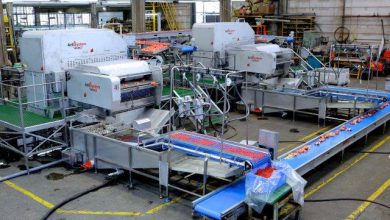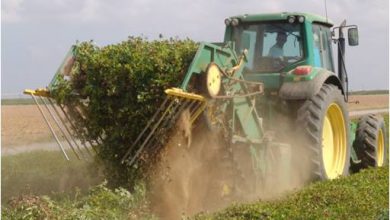Development of New Harvesting Machinery
New harvesting machinery offers increased amount of onion with less mechanical damage
I. Sagi, et al.


Introduction
In Israel farmers grow onions all over the country – from the Golan Heights to the “Arava” valley – over an area of about 2,000 acres. Most of the growing fields are small. The overall yield is about 100,000 tons and all of it is sold on the local market. In the past, most of the farmers harvested their yields by hand, which required many workers. The workers harvested the amount of onions required according to the daily market demand.
The reasons for harvesting by hand were; high mechanical damages caused by the machines and the need for a packing house. Due to the lack of laborers in agricultural work, about 10 years ago, the Israeli Ministry of Agriculture encouraged farmers to import machinery for harvesting onions.
A research team from the Institute of Agricultural Engineering was chosen to be responsible for testing the machines and making the necessary modifications in order to adapt them to local onion growth conditions. The project was financed by the head scientist of the Ministry of Agriculture. A set of onion harvesting machinery was imported by Kibbutz Yotveta in the Arava valley.
The machinery included a mower for cutting the foliage before harvesting, a digger for digging the onions and preparing a windrow on the ground for curing and a harvester for harvesting the onions into a container driven along the side of the harvester. The machinery was used to test the harvesting of different onion species in various areas around the country. In general, the test results were very poor. The mower worked fine but the digger and the harvester needed modifications of high cost in order to improve the harvesting and to lower the rate of mechanical damage to the onion.
The main conclusion was that the imported machinery is not suitable for Israeli harvesting conditions and there is a need to develop local onion harvesting machinery. The Israeli onions are grown on beds and harvested in two ways: 1. harvesting fresh onions; 2. harvesting dry onions. The fresh onions are harvested at the beginning of the season in two stages. After cutting the foliage, workers dig the onions by hand and put them on the ground for curing. About 3 days after they are collected, the onions are placed in boxes and sent to the local markets. The dry onions are collected directly from the ground, placed into boxes and sent to the markets.
Development of harvesting machinery.
According to the knowledge gained from the test results of the imported machinery and the study of the Israeli onion growth and harvesting conditions, a prototype digger and a harvester were designed and constructed. The digger (fig. 1) has a square and round bar digging system, a round bar conveyor mounted on the machine with two inclinations (15 degrees forward and 25 degrees backwards), above the front of the conveyor there is a rotor with 4 rubber wings, a digging depth automatic controller and a speed monitor to help the operator to adjust the conveyor speed to the tractor speed. The two inclines were designed to prevent onions from rolling at the front of the digger and to put them on the ground from behind at a low level. The rotor rubber wings help the onions climb onto the conveyor. The digger is operated by an 80hp field tractor using the a 3 point linkage.
Fig. 1. The digger digs and prepares a fresh onion windrow for curing.
The harvester (fig. 2) was designed for harvesting fresh and dry onions. Therefore, it has the same digging system as that of the digger. The harvester has two conveyors. The first one is a round bar conveyor mounted at a 15 degree slope in order to prevent back rolling of the onions. Above the front of the conveyor there is a rotor with 4 rubber wings to help the onions climb onto it. The second conveyor is a loading conveyor with 3 segments for loading different height containers and for folding them during road driving. The loading conveyor is mounted perpendicular behind the first conveyor. The top end of the conveyor can be adjusted during work to the height level of the container bottom in order to prevent mechanical damages. The harvester has an automatic depth control system, a conveyor speed measuring and adjusting system and a width balance controller to keep the harvester parallel to the ground. The harvester is drawn by an 80hp tractor on two wheels with an automatic return steering system. The harvester has a self hydraulic system for operating the conveyors and other components. The driver controls the harvester systems from the tractor cabin by an electronic controller.
Fig. 2. The harvester harvest dry onion and load a container
The digger was constructed by “Agromond Ltd.” and the harvester was constructed by “Juran Ltd.”. To date 3 diggers and 1 harvester have been constructed and are being operated by 4 Israeli onion growers.
Farmers that have onion packing houses collect and transport the onions in large hook lift containers. In the packing house the container is lifted and unloaded into a big hoper. This method of unloading causes the onions to fall and roll into the hoper from a high level, get damaged and lose their peels. In order to prevent unloading damages, a container with a bottom rolling conveyor was designed and constructed in cooperation with “Green Arava Valley”, “Ardom Growth” and The Ilan Haruvi Workshop (fig. 3).
Fig. 3. A hook lift container with a rolling bottom conveyor loaded with onions.
Authors & Partner Organizations:
I. Sagi1, Y. Kashti1, F. Geoola1, Y. Grinshpon1, L. Rozenfeld1, A. Levi1, R. Brikman1, O. Mishli2, E. Margalit3
1. Institute of Agricultural Engineering, ARO.
2. Kibbutz Yotvata
3. Agricultural Extension Services.
(Published in ISRAEL AGRICULTURE, 2011)




